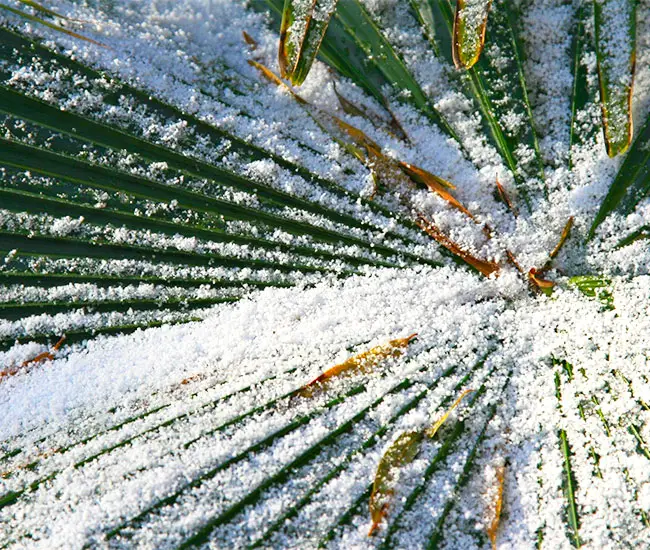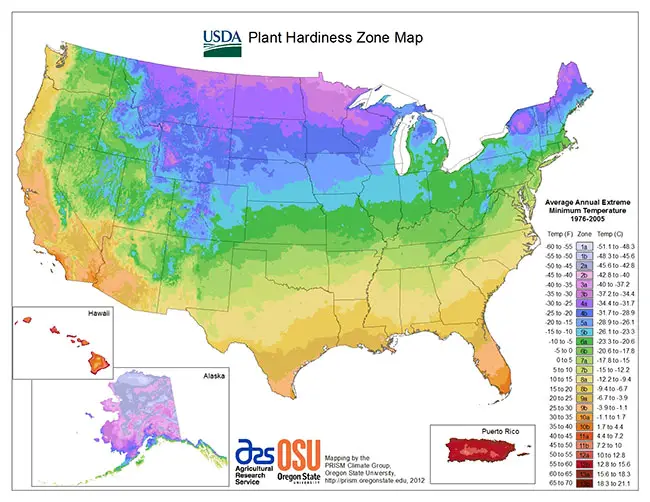
If you live in a cold climate and dream of having palm trees grace your garden, you’re not alone. Many gardeners in northern regions share the desire to create a tropical paradise right in their own yards.
The good news is that cold-hardy palm trees can thrive in a wide range of locations. Surprisingly, palm trees can be cultivated in as many as 40 states, with some cold-hardy varieties capable of withstanding temperatures as low as 0°F.
The key to successfully cultivating cold-hardy palm trees in a chilly climate lies in understanding your hardiness zone, the lowest temperatures your area experiences during the coldest months, which palm species are suitable for your region, and how to protect them from unexpected cold spells. All of these factors are equally essential for your palm’s well-being.
Your Hardiness Zone

Begin by determining your hardiness zone. Knowing your zone will help you narrow down the list of palm species that can thrive in your area. The United States Department of Agriculture (USDA) classifies regions into 11 zones, each with specific plant categories that can endure the minimum temperatures of that zone.
The USDA Hardiness Zone Map was first created in 1990, and the most recent version was published in 2012. What’s surprising is how much warmer the United States has become over the past 20 years.
Consequently, more palm varieties can now be cultivated in northern climates than previously thought.
While the USDA Hardiness Zone map provides an excellent starting point, it doesn’t account for factors such as heat, humidity, soil moisture, the number of frosty days, or the risk of rare, extreme cold snaps.
Cold Tolerances of Palm Species
The challenge of growing palms in colder climates arises from their natural affinity for warm and humid conditions. Since palm trees originated from various regions, some species can withstand colder temperatures better than others.
This is reflected in their cold hardiness, which measures the lowest temperature a palm can endure.
You’ll find a wide selection of cold-hardy palm trees that can pretty much grow anywhere. Among them, some are affordable and readily available, while others may be rarer and more costly.
Below, you’ll find a list of the 10 most popular cold-hardy palms, appreciated for their durability, ability to withstand cold temperatures, affordability, accessibility, and low maintenance requirements.
Top 10 Cold Hardy Palms
| Common Name | Scientific Name | Zone | Min. Temperature |
| Cabbage Palm | Sabal palmetto | 8a-11 | 10 to 15 F |
| California Fan Palm | Washingtonia filifera | 8a-11 | 10 to 15 F |
| Chinese Fan Palm | Livistona chinensis | 8a-11 | 10 to 15 F |
| European Fan Palm | Chamaerops humilis | 8a-11 | 10 to 15 F |
| Mexican Fan Palm | Washingtonia robusta | 8a-11 | 10 to 15 F |
| Needle Palm | Rhapidophyllum hystrix | 8a-10b | 10 to 15 F |
| Pindo Palm | Butia capitata | 8a-10b | 10 to 15 F |
| Sago Palm | Cycas revoluta | 8b-11 | 15 to 20 F |
| Saw Palmetto Palm | Serenoa repens | 8a-11 | 10 to 15 F |
| Windmill Palm | Trachycarpus fortune | 8a-11 | 10 to 15 F |
Here are more details on the most popular cold hardy palms. You can buy these palms at almost any nursery or online.
Understanding the Coldest Temperatures in Your Area
Another crucial factor to consider is how cold it actually gets in your region during the coldest nights. Many gardeners tend to make educated guesses when asked about their area’s lowest temperatures, but this information is often inaccurate.
For precise data, consult your local weather records or use a maximum-minimum thermometer during the winter months to determine the actual lowest temperatures. Don’t rely on guesswork.
Additionally, assess whether this low temperature is typical for most winters. Even tropical areas like Miami can experience unusually cold winters from time to time.
Those living on the borderline between different hardiness zones may encounter temperatures that are colder or warmer than what a zone finder might indicate. Generally, the warmer your area, the more palm tree varieties you can successfully grow.
Acclimatizing Palm Trees
Knowing the cold hardiness of palm species is just the beginning. Before planting palms in a cold climate, they need to undergo a process of acclimatization to adapt to lower temperatures.
If you purchase cold-hardy palm species that were initially grown in a tropical climate like Florida and have never experienced cold weather, they won’t survive in a colder region.
It is crucial to buy palms from well-known and trusted nurseries that acclimatize their palms before selling them to customers in northern regions.
This practice explains why some palm growers may achieve different results even within the same hardiness zone.
It’s worth noting that not all cold weather is the same. Research has shown that sudden cold snaps can be more devastating than gradual temperature drops.
When the weather gradually cools over an extended period, palm trees have time to slow down their processes and enter a dormant phase. During a cold snap, palms lack the preparation time, often leading to cold damage.
Microclimate
A microclimate refers to a relatively small area, often just a few yards or even smaller, that possesses a climate slightly different from the general climate of the surrounding region. You can create a microclimate by providing shelter for your palm trees using trees and shrubs.
Palms that are sheltered tend to have better chances of surviving cold weather compared to unprotected ones. Another way to establish a microclimate for your palm tree is by planting it near objects that absorb heat during the day and release it at night.
Objects such as rocks, buildings, fences, or paved surfaces can help keep your palm warmer during cold nights. Creating a microclimate in your yard can significantly expand the range of palm species suitable for your area.
Palm Tree Cold Protection
This brings us to the final key point: protecting your palm trees from cold snaps and extremely cold nights. You can achieve this by using warm covers, light bulbs, and heaters.
The most crucial part of a palm tree is its bud. If the bud gets damaged, the palm tree may not survive. Often, palm trees perish due to such damage.
If you plan on planting a palm tree, it’s essential to give it sufficient time to develop a strong root system before the cold weather arrives by planting it in the spring.
Regular fertilization can also make your palm tree stronger and more resilient to sudden temperature changes.
Related articles:
- Palm Tree Cold Protection
- How to Save Cold-Damaged Palm Tree
- Top 10 Cold Hardy Palm Trees
- Top 5 Factors Affecting Cold Hardy Palm Tree Growth


We would like to have suggestions for tropical plants for our friends in Nottingham. Which are the plants you propose and how xan we order them?
Thanks very much.
Evelyn Kortum